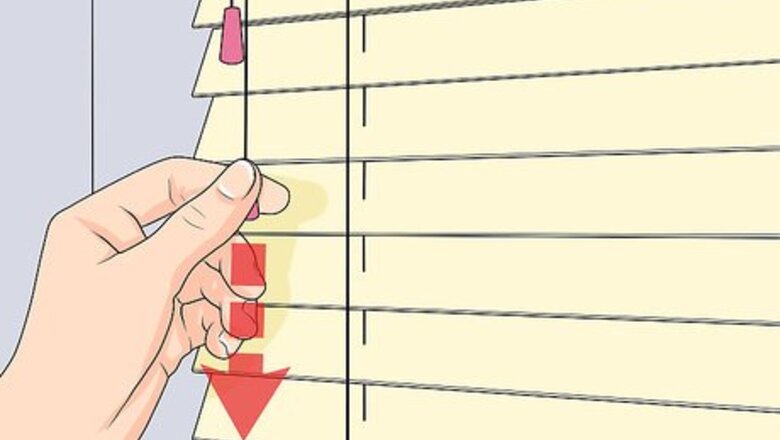
views
Securing and Pre-Treating Blinds
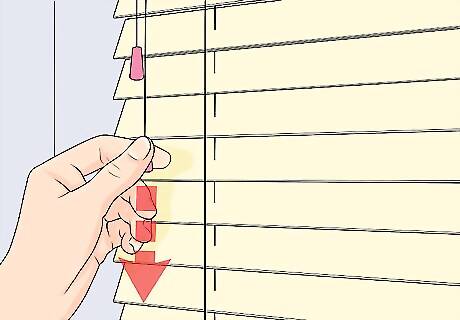
Lower the blinds and shut the slats to make them easier to clean. Lowering the blinds makes them easier to spread out for cleaning. After lowering them all the way down with the pull string, use the turning rod to adjust the angle of the slats. Position the blinds completely closed, like you're going for maximum privacy. Lowered blinds are bulkier than ones that are wide open, but it's necessary to have them this way. Just be careful if you plan on moving them.
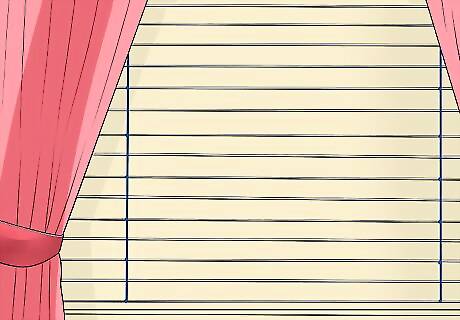
Tie back curtains and other furnishings around the blinds. Pull them to the side so they don't get in the way while you're cleaning. Wrap billowing curtains up in a band if they keep falling back in front of the blinds. You could also take them off the wall so you're better able to access the blinds. Move away any nearby furniture, toys, and other obstacles that could trip you up. Consider washing or vacuuming curtains to clean them up. It's easy to forget that they collect plenty of dust as well. Give yourself plenty of room to move around the blinds and set up a stepping stool if you need it. Nothing else needs to get soapy while you're cleaning, so keep it all away from your cleaning supplies.
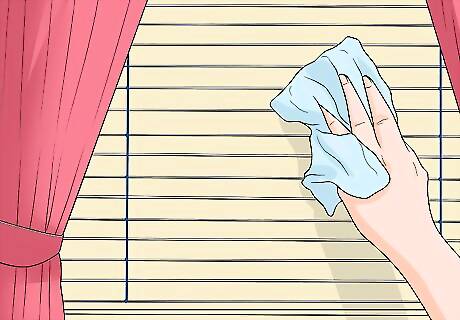
Wipe away any noticeable debris with paper towels before cleaning. Check the blinds for problem spots. You never know when random stains happen. Whether that is food, bug splatter, sticky spots, or spills, wipe up as much of the debris as you can so it doesn't spread while cleaning. Dry towels are enough for now. Try to clean spills and other issues when they're fresh so they don't have time to settle on the blinds. It makes routine cleaning much easier!
Clearing Dust off Blinds
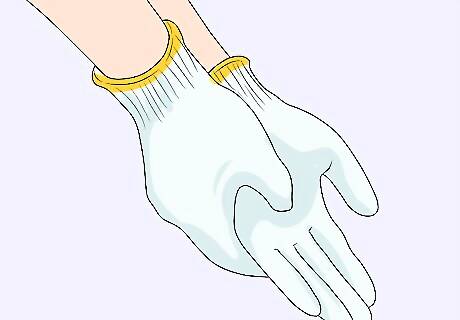
Choose a cotton glove or another soft dusting tool. Gloves enable you to reach around the Venetian blinds by hand, but there are many alternatives you can use. Many people like using an old sock. If you don't mind putting your hand in something that was on your feet, a sock is about as easy to use as a glove. Otherwise, you could use a clean, soft cloth or another piece of fabric. Many general stores sell dusting mitts. They are practically made for blinds and you won't find a better tool for light cleaning. Look for it along with any other cleaning supplies you need. Feather dusters are great ways to do some routine maintenance on your blinds. They are great for reaching higher spots on the blinds with ease but aren't as effective at clearing off individual slats. Other options include paper towels and clothes dryer sheets. Dryer sheets are good because they prevent static electricity that attracts dust. These products need to be swapped out as they get filthy with grime.
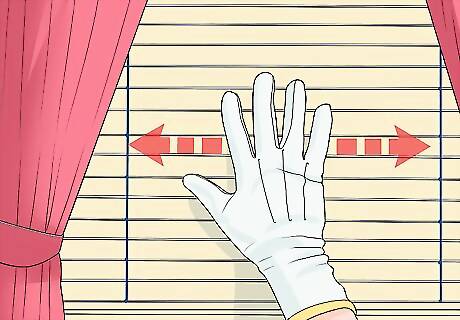
Run your fingers lightly over the slats and accessories. Start with the center of each slat and work toward the edges. Finish one side, then go back to the center and work toward the other side. You will need to do this for each slat, so it isn't the quickest process, but it does remove plenty of dust. Press as gently as possible on the blinds and don't squeeze them as you brush across the edges. Working from the center ensures you don't streak dust from one end to the other. Be sure to check your cleaning tool and replace it as it gets dirty. Remember to get any handles or strings hanging from the blinds. Scrub them the same way as the slats.
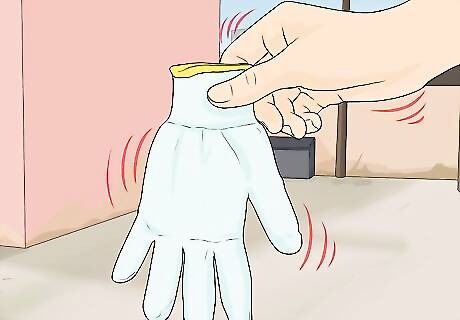
Change or clean your duster to avoid leaving dust on the slats. That dust has to go somewhere, and eventually, it's going to fill up your glove or cloth. Take it outside and shake it out to release the dust. You could also get a trash bag, stick your glove or duster in it, and shake off the dust. Do this each time your duster looks dirty to avoid putting dust back on the blinds as you clean them. For disposable dusting tools like paper towels, throw them away as they accumulate grime. You may need to go through quite a few of them depending on how dirty the blinds are, so it's not necessarily the most cost-efficient or eco-friendly solution. Dirty dusters can be washed in soapy water followed by a clean water rinse. Let it dry before you use it on the blinds again.
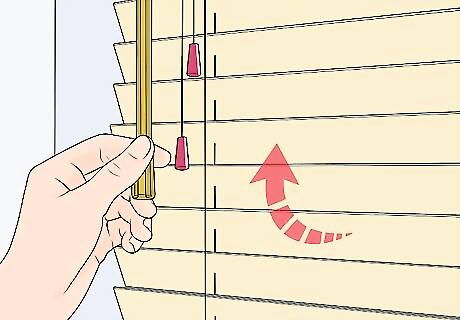
Flip the blinds around to clean the other side. Use the roller on the blinds to invert them. Adjust the slats so you are able to see their back ends, which normally face the window. Then, use your dusting tools to repeat the cleaning process. Wipe off each individual slat as well as the pull cord and other accessories. Slip behind the blinds if you need to in order to wipe down each slat. It's easier to adjust the slats using the roller, but you could still reach the other side if you are unable to move them.
Vacuuming Tough Grime off Blinds
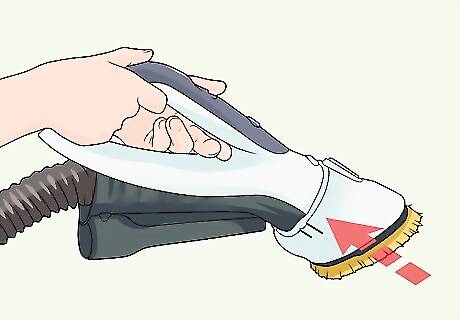
Attach a duster brush or an upholstery brush to your vacuum cleaner. You will need a vacuum cleaner with a hose in order to reach the blinds. Stick the brush attachment into the nozzle at the end of the hose. Use a duster brush if your vacuum came with one since it's soft and effective on delicate surfaces like blinds. Upholstery brushes are a little larger but still decent on blinds. Whatever you do, don't attempt to use the hose without a brush attachment. It's strong enough to pull the slats and scratch or chip them.
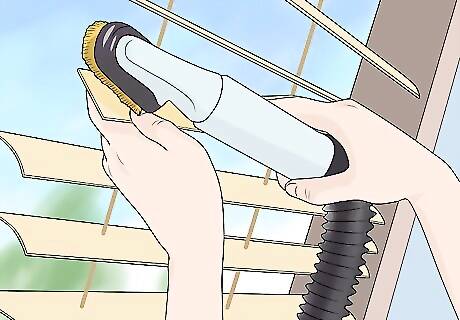
Hold the blinds still while you vacuum. Even if you have the right vacuum attachment, take no chances when vacuuming. Hang onto the slats as you move the vacuum along each one. You can simply grip the end of the slat to do this. As you move along the slat, shift to the other side to keep it steady. Nobody enjoys seeing their blinds crack and fall to pieces during routine cleaning. The slats can be delicate, so use caution whenever you are able to. Keep a firm grip on the slats so the vacuum hose doesn't suck them in.
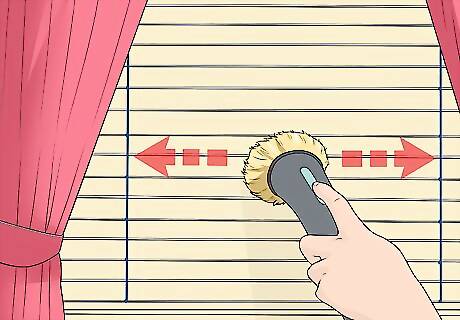
Move the vacuum from the center to the sides of the slats. Always follow the direction of the slats. For Venetian blinds, that means moving the vacuum hose to the right and left. Work one slat at a time, starting in the center with each pass. Go back over each blind until it is clean. Set the vacuum to the lowest power setting possible to reduce the chances of damaging the slats.
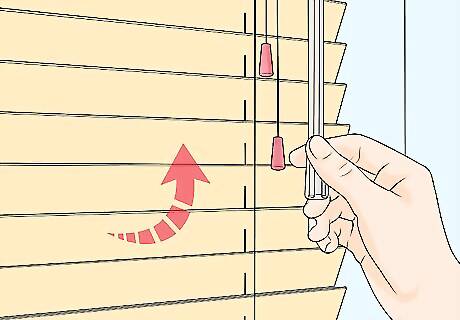
Open and reverse the slats to clean the underside of the blinds. Use the turning rod to spin the slat all the way around. There is dust on the side facing the window too, so now is a good time to take care of it. Go back over each slat a few times with the vacuum cleaner, remembering to work from the center of the slats with each pass. Check the slats for debris when you're done. You may need to go over them a few times to eliminate all of the dust.
Scrubbing Light Stains off of Blinds
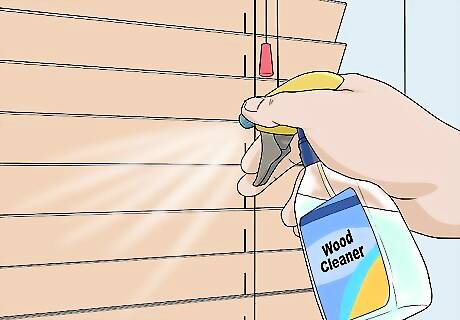
Use a wood cleaner to renew wooden blinds without damaging them. It's best to avoid soaking wooden slats in water. Instead, spray a wood cleaner or furniture polish on each individual slat. Use a clean cotton cloth or sock to rub the cleaner back and forth along the stain. Leave the cord and other accessories untouched for now to clean with water later. If you don't have a wood-specific cleaner, you may be able to lift a stain by scrubbing it with a very small amount of plain water. Moisten the sock or cloth and be prepared to dry the wood off when you're done. Most wooden blinds are treated with a finish that resists stains, so a dry wipe with a clean cloth is often enough to polish them.
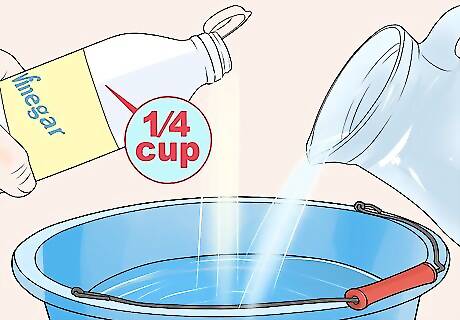
Mix together warm water and vinegar in a bucket for non-wooden blinds. Fill a bucket full of water, then stir in about ⁄4 cup (59 mL) of white vinegar. For a stronger solution, try making a mixture consisting of equal parts water and vinegar. You could also mix in an extra ⁄4 cup (59 mL) of a liquid dish soap instead of adding more vinegar. A mild detergent is one designed for general usage instead of cutting through tough grease. Remember to rinse off the soap with clean water when you're done scrubbing the blinds.
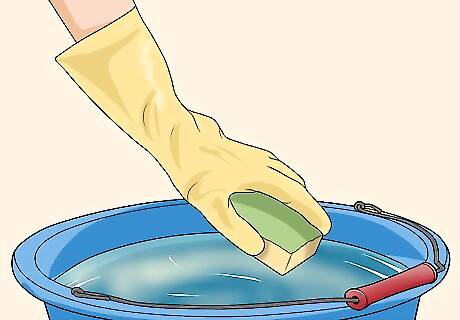
Dampen a clean cloth or sponge into the mixture. Choose something non-abrasive, such as a piece of cotton or the soft side of a sponge. Old socks make for great scrubbers when used on tough stains. Dip the scrubber into the water to moisten it, but don't soak it or else it will drip water everywhere. If you're using a sock, you could use it to grip the individual slats as you scrub across them. For hard to reach spots, switch to a cotton swab. Cotton buds are great for reaching into tight recesses.
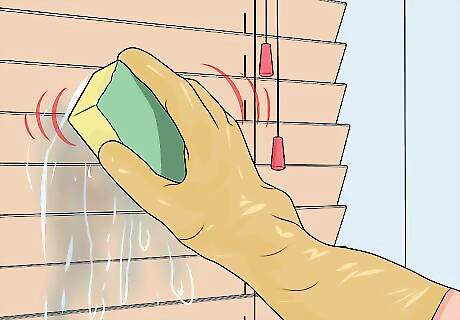
Wipe down the blinds until the stains wash off of them. Scrub horizontally along the blinds, starting in the center and working out toward the edge of each stain. Press down with a light amount of pressure so you don't end up bending the slats. Also, get the pull cord, headrail, and other accessories. Heavy stains need to be treated with a deep washing. It happens sometimes even if you take great care of your blinds.
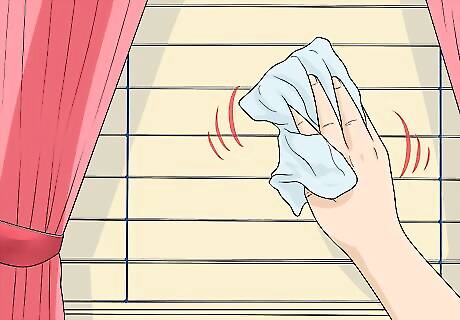
Dry the blinds with a cloth to finish cleaning them. Take a clean cotton cloth to the blinds right after you're done scrubbing, especially if you're working on wood. Sop up any moisture you notice and check to see if the stain disappears. Most stains will go away with a little bit of scrubbing. It also takes care of any remaining dust in the area. Repeated treatments can take care of stubborn stains, but use caution. You're better off performing a deeper cleaning than bending the slats out of place with furious scrubbing.
Giving Dirty Blinds a Deep Cleaning
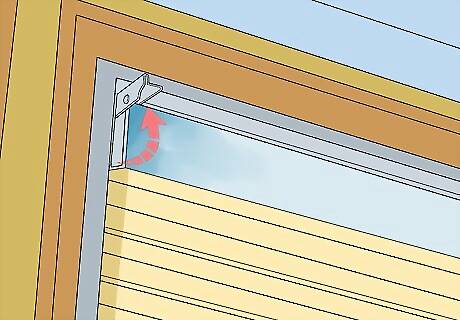
Remove the blinds by undoing the brackets at the end of the headrail. The brackets are on the sides of the headrail the slats dangle from. These brackets are relatively easy to pry open with a flat-head screwdriver. Open the bracket and pull the rail toward you to take the blinds off the wall. Not all blinds have the exact same locking mechanism, so check the owner's manual for more specific instructions. Generally, you do not need anything other than a screwdriver. Deep cleaning is recommended for metallic and synthetic blinds only. This is almost certain to damage wooden blinds, so try it at your own risk! Read the manufacturer's cleaning recommendations for a better solution.
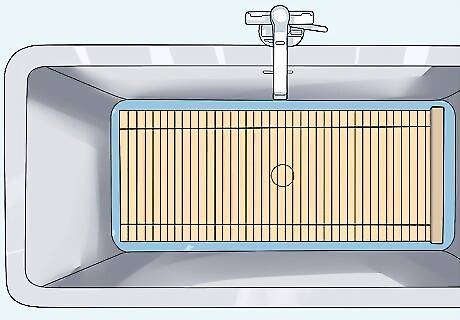
Spread the blinds on the floor of a bathtub. Consider laying a towel down on the bathtub floor first if you're worried about scratching the blinds. When you're ready to put them in the tub, lay them as flat as you can on the floor. If the blinds are a little longer than your tub, it's okay to fold the end over a little bit. Keep the headrail and other metal components out of the water, if possible, to prevent them from rusting. If you don't have space for the blinds in your bathroom, try moving them outside. Lawns and driveways are a few good spots for them. Lay out a tarp or blanket first to prevent them from getting even dirtier.

Fill the tub with warm water and add a liquid detergent. Let the water flow until it covers the blinds. Then, pour in whatever mild dish detergent you have in your kitchen. About ⁄4 cup (59 mL) of it will do. Also, add up to ⁄4 cup (59 mL) of white vinegar if you think you will need extra cleaning power to cut through grease on the dirtiest blinds. It isn't a lot of water, but keep some spare towels on hand to deal with any splashes or drips while you're cleaning. If you're cleaning your blinds outside, attach a garden hose to a nearby faucet. Spray down the blinds a few times until they are clean.
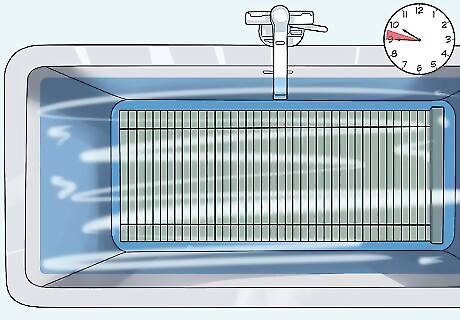
Leave the blinds to soak for at least half an hour. The amount of time you need to leave the blinds in the water depends on how dirty they are. If you brush dust off of them pretty regularly, it can take as little as 30 minutes. Blinds with a deep build-up of grime may need to be left for 3 hours or more. It's okay to leave the blinds in the water overnight if they really need the spa day. If you're in a hurry, try swishing the blinds around in the water. Use a soft scrub brush to help lift the stains.
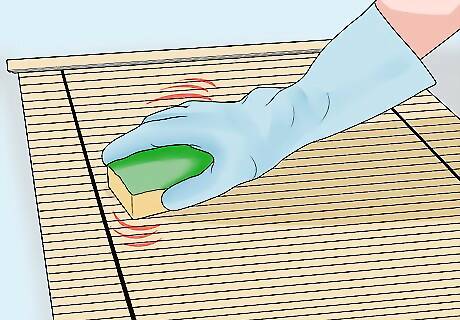
Scrub stains with a soft brush or sponge to remove them. Soaking may not be enough to remove the toughest stains. Fortunately, scrub brushes can come to your rescue. Make sure you choose something soft that won't scratch the blinds, such as a nylon kitchen brush, non-abrasive sponge, or soft cloth. Scrub along each slat with a gentle amount of pressure until they are all clean. Scrubbing is very useful for blinds done outdoors since you probably won't be able to soak them. Keep scrubbing and spraying them until they are clean.
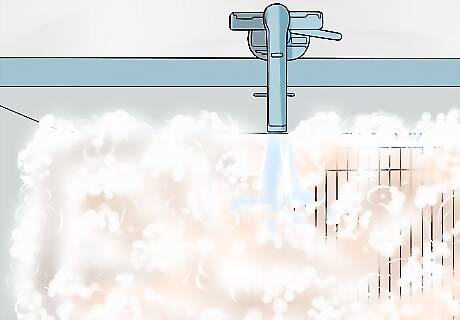
Rinse the blinds with clean water to remove the soap. Drain the tub, then turn on the clean water. A detachable shower head comes in handy here, but you're fine if you don't have one. Try using a bucket to slosh water onto the blinds or let the water spray onto it until the soap is gone. Check both sides for any remaining soap or stains. If you can help it, keep the blinds still as much as possible to avoid any risk of damaging them. If you have to move them, handle them gently and keep a towel under them.
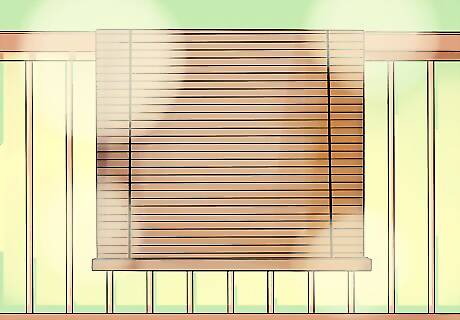
Hang the blinds in the air until they dry. If you're lucky enough to have good weather, drape the blinds over a railing, a fence, or some other place exposed to sunlight and circulating air. It will help the blinds dry out more quickly. You could also throw them over a shower railing, garage beam, or some other spot. Wait for them to become completely dry to the touch before hanging them back up on the wall. To speed up the drying process, wipe the blinds off with a dry cloth. You could also turn a hair dryer down to a very low heat setting and use it. Hold it about 8 in (20 cm) above the blinds and keep it moving. Keep the blinds away from heaters and radiators to avoid warping them. Avoid leaving them against hot surfaces.


















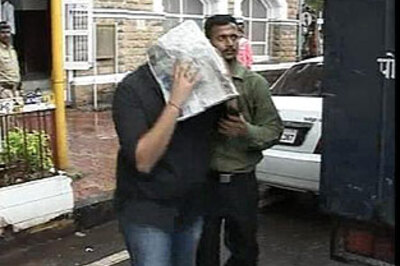

Comments
0 comment